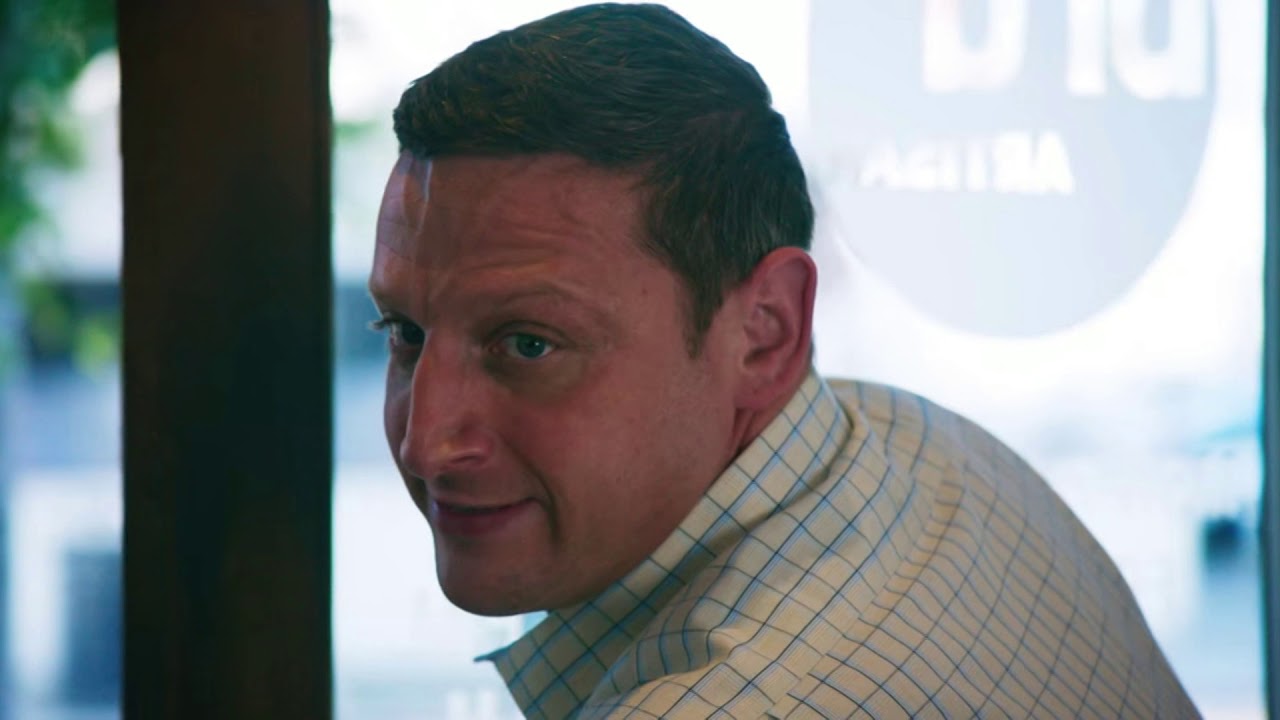Most people think of watching television as a way to relax, but in the streaming era—with multiple distinct services filled with dozens or hundreds of shows and movies each—the simple act of choosing what to watch might induce anxiety instead. With that in mind, we’re introducing What We’re Watching, a new column in which Spin staffers will champion the best thing they’ve seen on any streaming platform recently, whether it’s an obscure foreign show on Netflix or Hulu or a 45-second YouTube clip of a dog in a hat. We’ll try to focus on films and series that aren’t already dominating the media cycle, because there’s enough Game of Thrones coverage out there as it is. Old stuff is allowed, as long as it’s streaming somewhere; hopefully, everything will be new to someone.
I Think You Should Leave with Tim Robinson (Netflix)
Fifteen seconds into the fifth episode of I Think You Should Leave with Tim Robinson, a hot-dog-shaped car comes crashing through the window of a clothing store. As shoppers collect their bearings, they notice that the driver has fled the scene, and spring into action in hopes of catching the fugitive motorist. The camera cuts to the show’s creator, wearing a giant hot dog Halloween costume, shouting in support of the crowd as they question the connection between his attire and the vehicle. “It could literally be any one of us,” he says. Then he diverts the shoppers’ attention, fills his arms with merchandise, monologues about internet porn, makes a run for it, and flips off the cops.
Tim Robinson’s new sketch series might just be the best thing on Netflix right now, or at least the most efficient. The first season is easily watchable in a single sitting, packing what must have been weeks worth of sketch workshopping into six fifteen-minute episodes. Robinson is a former Saturday Night Live writer and cast member, but the tone is more like Tim and Eric. In an era when nearly all comedy shows the pioneering duo’s influence, this series stands apart in its ability to shift from tightly scripted setups into new frontiers of absurdist chaos.
Thanks presumably to Robinson’s pedigree and connections (he also co-created and -starred in Comedy Central’s Detroiters), I Think You Should Leave features guest appearances from alt- and mainstream comics like Will Forte, Andy Samberg, Kate Berlant, Brandon Wardell, Conner O’Malley, and Tim Heidecker himself. But Robinson is its unequivocal star, saving the most demanding roles for himself. Sketches about whoopee cushion office pranks and carnival organists at funerals can at times feel a little stale, but the show’s near-perfect pace is more than enough to make up for its occasional weak moments. I Think You Should Leave with Tim Robinson is proof that there’s still new and delightful territory to be explored within one of comedy’s most established formats. And at a time when keeping up with Netflix originals can feel like an insurmountable task, it won’t take you very long to watch.—ROB ARCAND
The Kettering Incident (Amazon Prime)
Certain shows—many of them supernatural thrillers—make it clear within the first 20 minutes of their pilots that their endings will be disappointing. Perhaps you’ve taken the bait, and you’re watching a show that walks the line between procedural and ghost story, or family drama and alien story, or some other similar combination. The future flashes before your eyes: no show could adequately wrap all the threads that so many of these programs dangle before us in their opening episodes.
Knowing my own proclivity for cerebral indulgences like these, I’ve come to wonder: Does any of that really matter? In many of the greatest speculative television shows of all time, the journey was far more edifying than any possible point of arrival. As they fleshed out their dizzying mythologies and ensembles of suspicious characters, and conceived of mystical red herrings to throw into the pot, they built labyrinths that even they must have known they couldn’t find their way back out of. David Lynch didn’t want the mystery of Laura Palmer to ever be solved. The X-Files’ Smoking Man and his cadre play some new 70-dimensional chess game in each new season, and loyal viewers have long accepted that the upshot of it doesn’t really matter: it’s a loose framework that gives the show’s monsters, paranoiacs, nerds, and diabolical scientists a context in which to run amok.
The Kettering Incident, an Australian paranormal procedural, has elements in common with both the aforementioned shows. It sends out warning signs that its ending will be dissatisfying almost immediately, as creator Victoria Madden introduces us to a small town full of comically suspicious people. Protagonist Anna Macy (Elizabeth Debicki) dances in a trance that she can’t remember later. A secret from her past still haunts her Tasmanian hometown, and for some reason, she has to go back there to face it. There are strange and elusive hippies who try to save the town’s surrounding forest from being cut down, and oversized moths that congregate at sites marked by X-Files-alien-abduction-style flashing lights. As in Twin Peaks, there is a mill that town officials will do all sorts of diabolical things to keep in business. Most importantly, there’s a teenage girl with multiple incongruous love interests, who is caught up in a drug ring, and possibly also black magic, and ends up dead. She even has a diary. It’s basically Lynch plagiarism, but somehow, it’s hard to stop the autoplay.
Like Dark, Netflix’s 2017 debut German production, Kettering mixes Peaks’s small-town weirdo-drama formula with a hefty dose of UFO paranoia. (Unlike Dark, it thankfully does this without finding any corny common ground with Stranger Things, visually or conceptually.) But it’s packed with more strange and compelling characters than the Netflix production. It’s also more frustrating, but its cluttered plot and hallucinatory weirdness are the source of its appeal. The show also gets a lot of visual and conceptual mileage out of the geographical and sociological peculiarities of its Tasmanian locale, remote and backwards enough to push even the most upstanding among its characters to desperate or unexpectedly vicious behavior. Kettering will keep you engaged and bewildered until its inevitable cosmic head-scratcher of a conclusion, which deserves respect, above all, for being uncompromising. —WINSTON COOK-WILSON
Eastern Promises (Hulu)
David Cronenberg’s is a brutally physical cinema. Though he’s probably best known for his contributions to horror—bodies turning inside out, heads spontaneously exploding, tooth-guns penetrating human faces—Cronenberg approaches even his more straightforward movies with a particular fixation on bodies and how they respond to extreme situations. After the psychological clusterfuck that was 1999’s Existenz, the celebrated director took a decade-long hiatus from directing his own original screenplays, and experimented with less overt modes of body horror. Even in these films, without all the mangled corpses and fanatical tech worshippers, Cronenberg’s attention to the visceral persists.
Eastern Promises is the undisputed gem of this period, infusing Cronenberg’s signature physicality into a relatively straightforward gangster movie. After a teenage mother dies in childbirth in a London hospital, a midwife finds a Russian diary on the body; she soon finds herself in over her head with a particularly ruthless subsection of the Russian mafia, reconciling her own Russian heritage with that of the mobsters with whom she’s now involved. The story itself is engaging, anchored by excellent performances from Viggo Mortensen, Naomi Watts, and Vincent Cassel, but it’s Cronenberg’s direction that makes this movie so special, with carefully orchestrated shots that stay with you long after the movie is over. From the opening barbershop murder to the classic bathhouse ambush, the camera tracks these mobsters intimately, paying the same close attention to glasses of vodka and bloody bodies.
While the bathhouse scene is the film’s clear centerpiece, I find myself thinking more about the overarching dynamic between the two central mobsters, the bratty boss’ son (Cassel) and the young outsider prodigy (Mortensen). Though their relationship is clearly and inevitably strained, their physical interactions (their hugs, their brawls, their laughs) betray a kind of sad love for each other. Deceit and disarray are Eastern Promises’ governing principles, but they’re inextricably tied to family—Cronenberg’s understanding of that tension is bodily as much as intellectual. –WILL GOTTSEGEN
Fighting In The Age of Loneliness (YouTube)
SB Nation writer and YouTuber Jon Bois is a mad scientist, crafting bonkers stories out of deep statistical research, drawing on subjects from the far reaches of sports and pop culture. Whether it’s a deep dive on the post-9/11 American terror-porn of 24 or an insane experiment to figure out if Barry Bonds would be a good baseball player even without using a bat, Bois’s hyper-specific studies and oddball humor are constant sources of delight, teaching while making you laugh and marvel at the audacity and the hours of labor and experimentation that clearly show in the work.
Bois made the four-part YouTube series Fighting In The Age of Loneliness in collaboration with Felix Biederman of Chapo Trap House. The pair focus on the rise of mixed martial arts from fringe underground phenomenon to huge corporatized success, setting this trajectory against the backdrop of the 2008 recession and ensuing fallout, suggesting that MMA was an outlet for the decimated hopes of many middle- and lower-class people. If you’re preemptively rolling your eyes at the prospect of yet another attempted explanation of how the U.S. arrived at a moment when Donald Trump could become president, know that Fighting In The Age of Loneliness is at its best when discussing MMA itself. As the country crumbles and disappoints us in new ways every day, sports—even at their bloodiest, weirdest, and most alienating—are a bastion of joy and unity, offering a chance at redemption, if only for a few moments. The show also offers a devastating but familiar look at the way some small communities lose their identity or die altogether after going mainstream. You won’t feel good at the end of Fighting In The Age of Loneliness, but you won’t feel alone.—ISRAEL DARAMOLA
Flowers (Netflix)
You’d have hard time coming up with a more depressing premise than that of Flowers, which first aired in 2016 on the U.K’s Channel 4, and takes place in the aftermath of a failed suicide attempt. Julian Barratt gives quiet gravity to the role of Maurice Flowers, the struggling author of a once-beloved series of children’s books; Olivia Colman is his wife Deborah, who struggles under the weight of her husband’s misery to maintain her own tenuous grasp on life’s joys, and to hold their strange family together. Maurice, feeling used-up and inadequate, tries to end his life in the first episode, but finds he can’t even do that successfully.
Given the dark comedy pedigrees of the players involved, it should not be surprising that Flowers mines Maurice’s predicament for all the bitter irony it’s worth. The show avoids moralizing and unearned sentimentality, presenting its characters as people with complicated inner lives—petty hang-ups, intense crushes, noble ambitions, and most importantly, senses of humor—rather than as one-dimensional victims to be saved. The second and final season focuses on the couple’s adult daughter Amy, a composer of foreboding modern music who seeks to understand her inherited trauma and synthesize it in her work. The treatment of avant-garde art as a worthy dramatic subject in these episodes, and the feverish depiction of Amy’s creative process, are unlike anything else I’ve seen on TV. With a surreal flair and keen sense of life’s small and large absurdities, Flowers offers an uncommonly truthful depiction of mental illness, one that is both crushingly sad and ridiculously funny.—ANDY CUSH
“Perry Farrell Announces Bin Laden is Dead”
Most people remember where they were when they heard Osama bin Laden had been killed. Perhaps you learned when former President Obama interrupted an episode of Celebrity Apprentice eight years ago to hold a press briefing. Or perhaps you were in Houston, watching Jane’s Addiction play, and got the news directly from the man who sang the Entourage theme. Perry Farrell’s messianic complex is on full display in this insane video from the fateful evening: holding a Christ pose, arms outstretched, basking in the applause from the crowd. Every time I watch this clip (more times than I’m comfortable admitting) I’m drawn to a new aspect of Farrell’s announcement. Sometimes I’m processing the fact that news of the death of one of the world’s most notorious terrorists is being delivered from a guy wearing a leather vest and jaunty little neckerchief. Other times I’m taken with shirtless Dave Navarro in the background, raising a celebratory fist in the air while a cigarette hangs from his mouth, then wiping sweat from his brow with a bandana and tossing it into the crowd. Sometimes the crowd’s “USA” chant takes me back to the time Boston bomber Dzhokhar Tsarnaev’s capture was announced over the loudspeaker at a Mets game I attended in 2013, followed almost immediately by a “Harlem Shake” video on the Jumbotron and t-shirt cannons firing into the crowd. The video is a rich emotional tapestry, is all I’m saying. Like a painting by Monet or film by Ingmar Bergman, it offers the viewer a new experience every single time.—MAGGIE SEROTA





